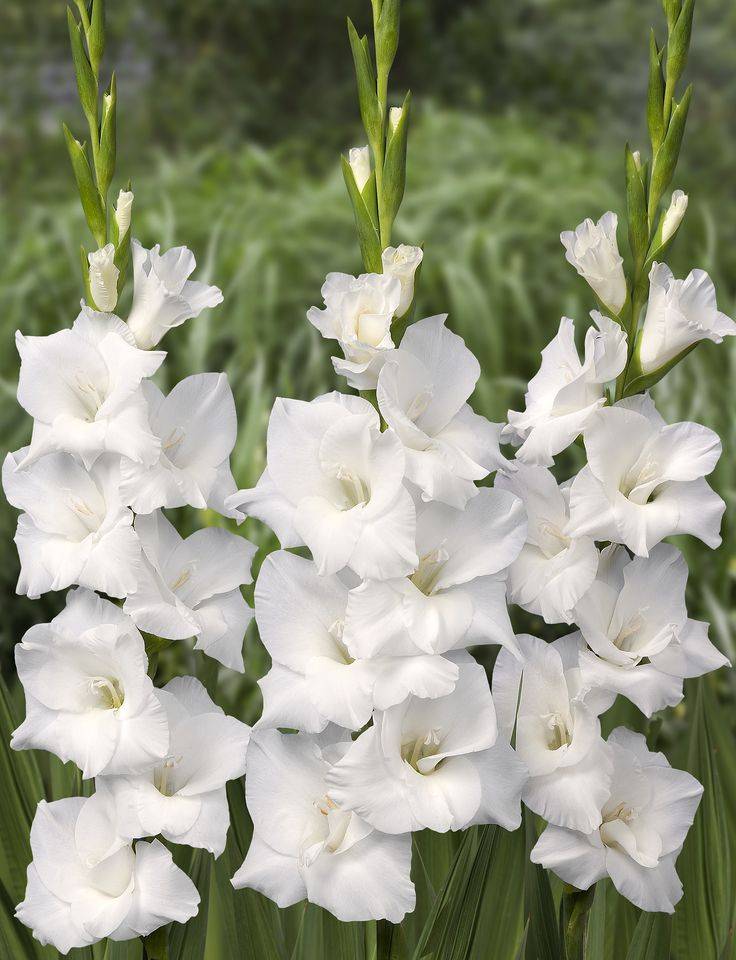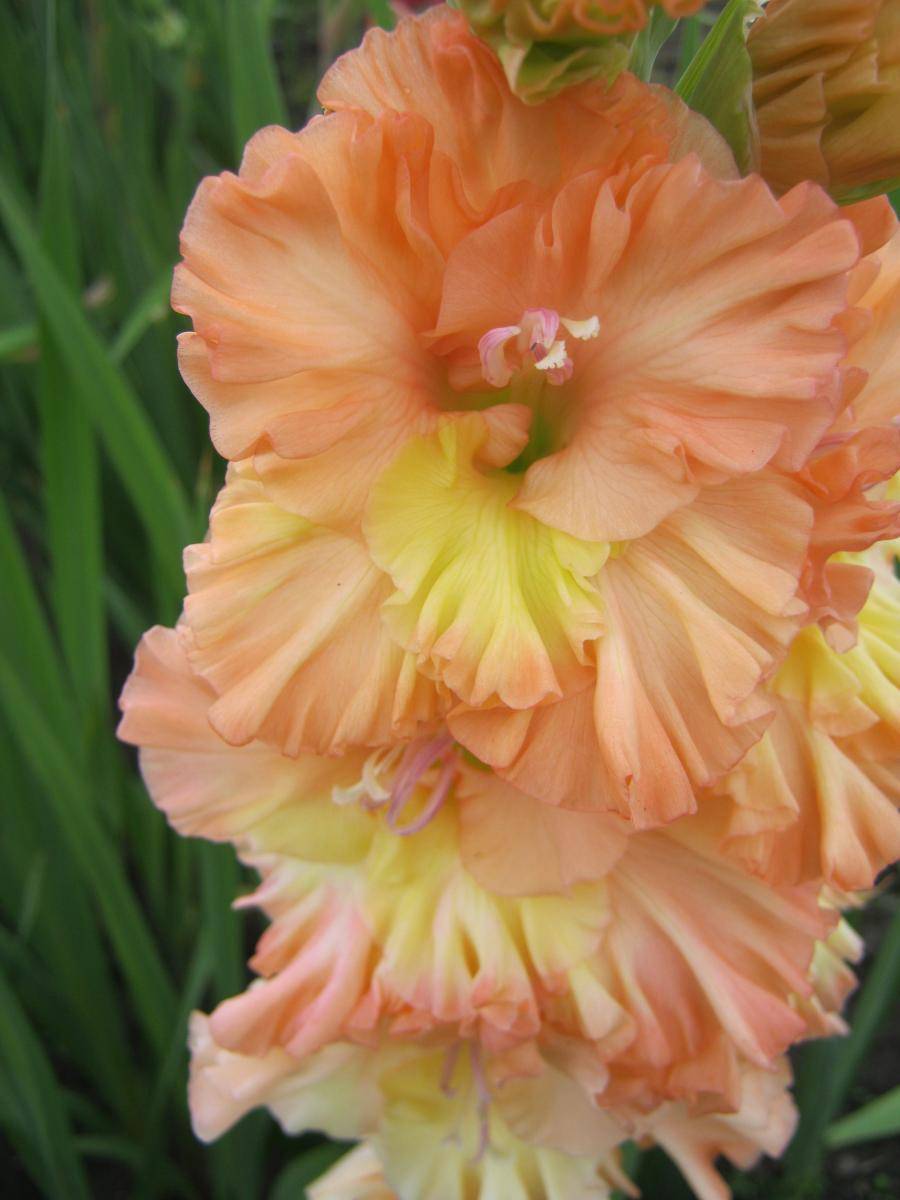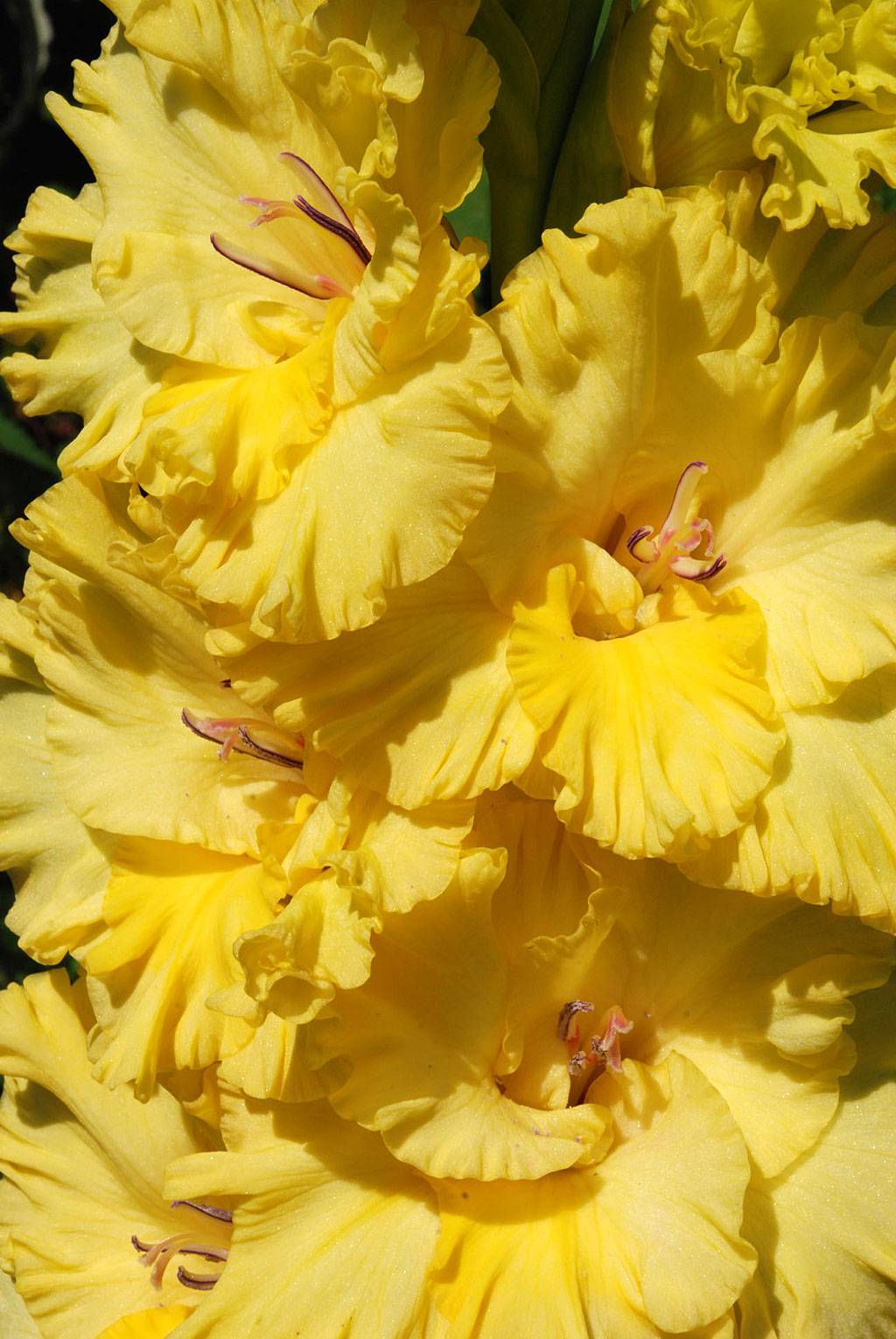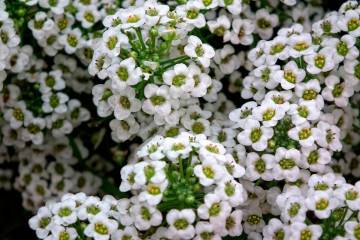Perennial gladiolus flowers - description
Content:
An irreplaceable decoration of any garden is the royal flower - gladiolus. Its stately and proud appearance, as well as the abundance of colors and colors, will not leave anyone indifferent. It is impossible to take your eyes off the flower bed with gladioli, and beautiful legends are made about the origin of these amazing flowers.
General information about colors
Gladiolus flowers belong to the Iris family and are perennial corms. They reach a height of 1 m. The leaves of a rich green color are long and pointed at the ends, they grow on a straight and dense stem. Spike-shaped inflorescences with a high density of flowers, which may vary in size.
The gladiolus flower according to the description can be of different colors. Most often, gladioli are found:
- snow white;
- beige;
- light yellow;
- light green;
- pink;
- orange;
- coral;
- lilac;
- blue;
- purple;
- bright red.
When gladioli are in bloom, it is impossible to take your eyes off them. Depending on the variety, this can occur from the first summer days to the beginning of autumn. Nowadays, these flowers are considered among the most popular and are highly regarded for their decorative qualities.
Popular varieties
It is almost impossible to meet a person who does not know what a gladiolus is. These amazingly beautiful flowers are a decoration of any garden. As a result of crossing by breeders, a large number of multi-colored hybrids were obtained, which were subsequently divided into groups, depending on their origin. In total, today there are 5 groups of these flowers:
- large-flowered;
- primrose;
- butterfly-shaped;
- miniature;
- wild.
The following are considered the best varieties of Russian selection:
- Snow White is a white flower, characterized in that it can stand in the cut for a long time. The height of the peduncle is about 70 cm. It belongs to the large-flowered group and is ideal for creating floristic compositions;
- Mother winter. At numerous exhibitions you can find this particular variety. It is distinguished by its large pure white flowers;
- A royal gift. This variety of gladioli stands out among all the others in white color with characteristic pink strokes on the lower part of the strongly crimped petals;
- Berendey's gifts are one of the most beautiful varieties of Russian selection. Flowers of a delicate light green color. The variety is highly resistant to temperature extremes;
- Peacock feather. Flowers of this variety stand out for their original color. The lower petals of the flower are bright green, and the upper ones have a salmon border;
- Margarita. In height, this variety grows up to one and a half meters, the petals are super-corrugated greenish;
- The canary solo is one of the most amazing gladioli. This flower favorably combines pink, salmon and yellow shades. Elongated petals;
- Sokolniki.Pale orange petals combined with green leaves look very impressive. In height, this gladiolus grows up to one and a half meters, while the length of the peduncles reaches 80 cm;
- Mlada is a spectacular flower with pink-salmon tints of petals. Looks great both singly and in compositions;
- The crown is a very glamorous scarlet flower with a silvery border along the edge of the petals. On a strong and powerful ear, up to 20 buds are immediately able to bloom.
These are not all popular varieties of gladioli. Will not leave indifferent such of them as Cherry tree, Hungarian lilac, Blue palette, smoky, Marble goddess, etc.
Flowering period
Almost everyone knows what a gladiolus looks like, but not everyone knows about the period of their flowering. Depending on the timing of flowering, gladioli are divided into:
- early - flowering period occurs in mid-July;
- medium - begin to bloom in mid-August;
- late - flowering begins in September.
How to speed up the flowering of gladioli
In order for gladioli to bloom earlier, you can use the following recommendations:
- preparation of bulbs for planting should be carried out in March. To do this, they should be planted in separate pots and placed in a well-lit room;
- before planting, you can soak the planting material in a solution of ash and trace elements. In this case, the plant will receive the necessary nutrition in sufficient quantities and bloom ahead of time.
Proper care of flowering plants
When gladioli bloom and after flowering, they need proper care. As soon as the plant begins to produce flower stalks, it must be tied up. During the period of flower formation, it is necessary to provide the plant with systematic and thorough watering. During budding, potassium nitrate is necessarily introduced into the soil.
How to prolong flowering
Garden and backyard owners want to enjoy the color of gladioli for as long as possible. You can prolong flowering in one way - by planting the bulbs at intervals of approximately 14 days.
Cut for a bouquet
Gladioli are a very beautiful and ideal culture to create a bouquet. But, so that cutting does not negatively affect the plant, it must be done correctly. To do this, pierce the peduncle with a sharp garden knife, then break it and, slightly shaking it from side to side, pull it out.
Basic rules for growing
So that in the process of growing perennial or annual gladioli there are no problems, and they bloom for a long time, you must adhere to the following recommendations:
- it is better to plant flowers in a well-lit and draft-protected area;
- the soil is best selected loamy or sandy loam;
- before planting, it is recommended to process the soil and add peat, ash and fertilizers to it;
- it is better to refuse to plant gladioli in a swampy area;
- plants should not be watered with cold water.
When can you plant
Planting times are best adjusted according to weather conditions. The most optimal is the period when the earth at a depth of about 12 cm warms up to a temperature of 10 ° C.
Gladioli care
In order for the flowers in the flowerbed to grow well, and the flowering period to be long, it is necessary to properly care for the plant.
Watering
Watering flowers is best done early in the morning or in the evening. Watering frequency - once a week. For 1 m², it is necessary to pour about 12 liters of water.
Weeding
Throughout the entire cultivation period, it is necessary to weed the soil around the flower in a timely manner and prevent the appearance of weeds.
Top dressing
Gladioli need to be fed throughout the summer. To do this, you should use various mineral fertilizers. The first feeding is carried out during the formation of the first true leaf plates. During this period, nitrogen fertilizers must be applied.
The second time fertilization should be applied as soon as 5-6 leaves are formed on the plant. The third time, before the formation of buds, phosphorus-potassium fertilizer is applied to the soil. When gladioli bloom after planting, every 15 days the plant is fed with mineral fertilizers.
Possible growing problems
There is always a risk of problems when growing gladioli. This is mainly due to common viral and bacterial infections. Such problems can lead to the fact that the plant will not develop well and will not be able to bloom. To prevent this, you need to take care of the flower, performing all the necessary actions.
Insect pests that like to feast on the pulp of corms can damage the flowers. The most common are thrips and ticks. You need to fight them with insecticides.
With proper care, gladioli are sure to be the center of attention of any flower garden. These flowers, ideal in all respects, will delight their owner with abundant and spectacular flowering throughout the month. Which variety to choose for decorating a flower garden, everyone decides independently. At the same time, it is very easy to care for these plants. The most important thing is to properly prepare the planting material.





















